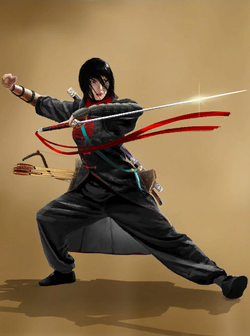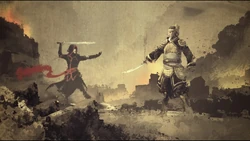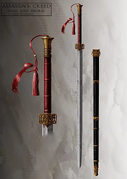
|
Patience, brothers. Soon we will reveal the secrets of Assassin's Creed: Origins and Assassin's Creed: Dynasty. This article has been identified as being out of date. Please update the article to reflect recent releases and then remove this template once done. |

Shao Jun wielding her jian
A jian is a one-handed, double-edged straight sword of Chinese origin. As an ubiquitous weapon among the Chinese, it was employed by the Chinese Brotherhood of Assassins throughout its history.
Description[]
The lightweight jian is a sword defined by its straight, double-edged blade. A perfectly symmetrical sword, its guard is conventionally triangular and takes the form of two short wings on either side of the blade; nevertheless the overall profile keeps protrusions to a minimal. Its grip, terminating in a pointed lobe for a pommel, matches the sleekness of the blade.[1]
Techniques for wielding the jian effectively in combat is an art form reflective of traditional Chinese martial arts. Unlike the destructive style of the dao, the jian requires far more elegant and precise maneuvers that complement the agile style of an Assassin such as Shao Jun.[1]
History[]
The jian and its art has a millennia-old tradition in China. By 47 BCE, one had found its way alongside its wielder all the way to the gladiator arena in Cyrene, Libya within Roman territory. The acrobatic Chinese gladiatrix known only by the moniker "The Duelist" used her jian skillfully in conjunction with a dao, climbing the ladder to become its champion before she was unseated by the Medjay Bayek of Siwa.[2]
The 16th century Chinese Assassin Shao Jun was highly trained in the jian, and it became her personal weapon of choice. Accordingly, she wielded one in her journey to Italy with her Mentor Zhu Jiuyuan to seek the help of the legendary Mentor Ezio Auditore against the Templars that had purged their Brotherhood. In at least two ambushes by Chinese Templars in Florence and at Ezio's villa, she made great use of the weapon to dispatch her enemies.[3]

Shao Jun facing Zhang Yong with her sword drawn
Upon her return to China in 1526 as one of the only surviving Chinese Assassins, Jun continued to rely on her jian throughout her campaign to assassinate the Eight Tigers, a group of corrupt eunuchs that led the Chinese Rite of the Templar Order. It is with the jian, and not the Hidden Blade as is usual for an Assassin, that she assassinated four of the Tigers,[4][5][6] including their leader Zhang Yong at the Great Wall in 1532,[7] whereupon she was able to begin the process of reviving her branch of the Assassins.[1]
Long after Shao Jun's death, the Templar-run front company Abstergo Industries had acquired her sword by 2016 and kept it alongside her other equipment they had at the Abstergo Foundation facility in Madrid, Spain. There, they hoped that its presence would prove a physical aid for Shao Jun's imprisoned descendant Lin to better aid in her synchronization when using the Animus 4.3 to relive Shao Jun's memories.[8]
Behind the scenes[]
In Chinese, jiàn (劍) is the common word for "sword" though it properly refers to any double-edged straight sword regardless of cultural origin. This is in contrast with the word dāo (刀), which refers to any single-edged, curved sword or saber.
Appearances[]
- Assassin's Creed: Embers (first appearance)
- Assassin's Creed III
- Assassin's Creed: Initiates
- Assassin's Creed IV: Black Flag
- Assassin's Creed Chronicles: China
- Assassin's Creed: Origins
- Assassin's Creed: Blade of Shao Jun
- Assassin's Creed (film)
- Assassin's Creed: Rebellion
- Assassin's Creed: Dynasty
Non-canonical appearances[]
- Assassin's Creed: The Ming Storm
- Assassin's Creed: The Desert Threat
- Assassin's Creed: Turbulence in the Ming Dynasty
Gallery[]
References[]
- ↑ 1.0 1.1 1.2 Assassin's Creed Chronicles: China
- ↑ Assassin's Creed: Origins
- ↑ Assassin's Creed: Embers
- ↑ Assassin's Creed Chronicles: China – The Escape
- ↑ Assassin's Creed Chronicles: China – The Slaver
- ↑ Assassin's Creed Chronicles: China – Demon Fire
- ↑ Assassin's Creed Chronicles: China – Vengeance
- ↑ Assassin's Creed (film)


